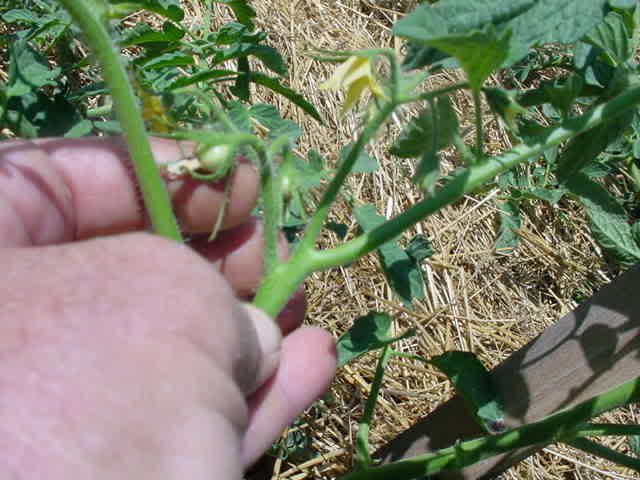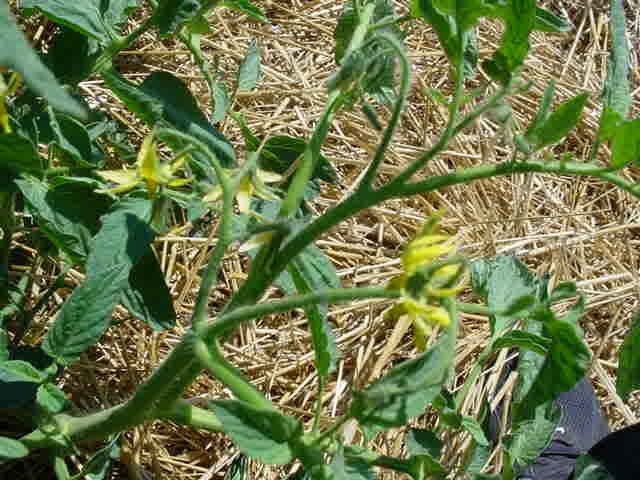

|
Forum area for discussing hybridizing tomatoes in technical terms and information pertinent to trait/variety specific long-term (1+ years) growout projects.
|
 |
|
|
Thread Tools | Display Modes |
|
|
#1 |
|
Tomatovillian™
Join Date: May 2013
Location: Honey Brook, PA Zone 6b
Posts: 399
|
I'm not planning on breeding for this at the moment, but I thought this article gave an excellent description of the differences between determinate, semi-determinate and indeterminate and how the genetics work:
Genetics of Semideterminate Growth Habit in Tomato Basically, Indeterminate is dominate sp+/-- Determinate is recessive to Indeterminate sp/sp Semi-determinate is only expressed when the plant is homozygous for Determinate (sp/sp) and there is a 2nd recessivev gene present that cause more inflourences and more nodes between (sdt/sdt) them (but environmental factors influence the expression of both sp/sp and sp/sp sdt/sdt plants) So data from the table in the article Indeterminate sp+/-- sdt/sdt Indeterminate sp+/-- Sdt/-- Determinate sp/sp Sdt/-- Semi-determinate sp/sp sdt/sdt Chris |
|
|

|
|
|
#2 |
|
Tomatovillian™
Join Date: Feb 2012
Location: Newfoundland, Canada
Posts: 6,793
|
Much appreciate you posted this, Chris...
I'll have to stop and think about the expected outcome of last year's cross involving F1 and F2 with determinate and semi-determinate traits... Semi-determinate is a really nice growth habit, but doesn't seem to be very common. And I must say, no wonder! The sdt/sdt crosses with indeterminate plants I made, will have only 1/16 chance of finding a semi-determinate in the F2...  Humbug! Humbug! 
|
|
|

|
|
|
#3 |
|
Tomatovillian™
Join Date: Jun 2010
Location: England
Posts: 512
|
Chris, I am glad you posted this article. I have never grown a tomato plant that I would have described as semi-determinate and was beginning to wonder if it was a tomato myth.
"Semi-determinate" is a term that is bandied around in a random fashion on tomato forums and blogs and is often used to describe varieties that are not truly semi-determinate. Good to see the name of the actual gene involved and the accurate description of the phenotype. |
|
|

|
|
|
#4 |
|
Tomatovillian™
Join Date: Feb 2012
Location: Newfoundland, Canada
Posts: 6,793
|
I agree, Maf, it's very confusing and difficult to find 'really' semi-determinate (or even determinate, sometimes!) plants based on the casual discussion or even seed catalogue descriptions... a clear definition is refreshing. Still there are environmental effects on gene expression, which make it even more difficult to differentiate determinate and semi-det in the field. There is really a continuum within the determinate group as well, as to the height and number of branches before forming a terminal bud...
This is from the article Chris linked about 97L97 in the colour genetics thread: "Line 97L97 tended to be semideterminate under Califor- nia growing conditions. (Plants with delayed termination of the main stem, thus more in- florescences, are termed semideterminate.) Semideterminate growth habit is controlled by a recessive gene, sdt, and may not be expressed under some environmental condi- tions (Elkind et al., 1991). Genetic variation in the number of inflorescences on the main shoot may also occur in determinate geno- types, however, resulting from the timing of formation of the final two inflorescences (Cuartero and Cubero, 1985). Additional analysis is required to distinguish between these genotypes in 97L97." The tomato parent of 97L97 is Floradade, described elsewhere as a 'large determinate' and 4-6 ft tall... sounds semideterminate. Unfortunately it's a hot weather variety, not so useful for climates like yours and mine. Zolotoe Serdtse is the one I've grown and believe to be semi-determinate... but I'll have to do some counting to confirm this by the definition given. |
|
|

|
|
|
#5 |
|
Tomatovillian™
Join Date: Jan 2006
Location: Evansville, IN
Posts: 2,984
|
Regardless of all the technical formalities with regard to the genes said to be operative, I have selected some excellent semi-determinate lines from an original cross of Mozark x Sioux.
Since I cannot confirm the presence of the genes said to be necessary to express semi-determinate growth pattern(s), I must go solely on observation. From the cross I mentioned, I have obtained, during and after the F3 generation, plants that express fully indeterminate, fully determinate, and obviously semi-determinate growth patterns. My favorite growth pattern is the semi-determinate. And I hope to incorporate it into other lines that include heirloom parental inputs. |
|
|

|
|
|
#6 | |
|
Tomatovillian™
Join Date: Feb 2012
Location: Newfoundland, Canada
Posts: 6,793
|
Quote:
|
|
|
|

|
|
|
#7 | |
|
Tomatovillian™
Join Date: Jan 2006
Location: Evansville, IN
Posts: 2,984
|
Quote:
At the top of the third column of the second page, it explains the semi-determinate main stem following specific inflorescent spacing and number patterns, and eventually terminating the meristem with an inflorescence, same as does a determinate meristem. The second paragraph in that same column seems to lump any variances beyond sp+, sp, and sdt inflorescence patterns into a convenient "due to environmental factors" category. Am I reading this correctly? So, my questions are as follows: If over the past several years, and from several F-generations of grow-outs, I have found plants from my Mozark x Sioux cross that follow the three general patterns laid out in the paper, but In addition, I have found two other inflorescence patterns that do not conform to those dictated by this paper, must I conclude there still are only 3 genes operative (sp+, sp, and sdt), and the two other patterns I have found must be lumped into the "due to environmental factors" category? Or ... Are there other genes involved but not yet identified by this paper? For example, I have a recurring pattern, thus: Once the inflorescences begin, they continue to emerge on every other internode (two leaf nodes between each inflorescence as with determinate and semi-determinate) yet there is no terminal meristem, and the vine continues until killed by frost (as with indeterminate growth pattern). This pattern cannot be categorized as indeterminate, because there are not the three internodes between inflorescences as dictated by the paper. And I don't accept that this pattern is "due to environmental factors" because I have observed it in three F-generations, and over three growing seasons with significantly different prevaling weather conditions. Should I call this pattern "semi-INdeterminate" and assume there is a fourth gene involved? Here is another "off type" pattern I have observed: Once the inflorescences begin, the pattern is thus: inflorescence on the internode, followed by an internode with no inflorescence, followed by an inflorescence emerging directly opposite of the next leaf node, then no inflorescence in the internode above the node with the inflorescence growing out the opposite side of the stem. Repeat the pattern as described, essentially saying there is a 1 and 1/2 internode spacing until the meristem terminates. This pattern continues to six or more inflorescences on the meristem before terminating (as with sdt). What is this? "Due to environmental factors?" Sdt+ ? Last edited by travis; January 24, 2015 at 03:48 AM. |
|
|
|

|
|
|
#8 |
|
Tomatovillian™
Join Date: Feb 2012
Location: Newfoundland, Canada
Posts: 6,793
|
When a unique growth pattern is fixed for several generations, it can't be fobbed off on 'environmental' causes... no sense invoking environment either when several siblings in the same environmental conditions have different growth patterns!
The conclusions in the paper are based on a study involving only one variety each of 'determinate', semi-det, and indet... The year I grew many determinate varieties I was pretty astounded by the variety of growth habits. The small stature of some of them was partly due to short internodes (a QTL trait afaik) but also due to having only one leaf between inflorescences.. Others had two leaves between inflorescences. It stands to reason that there is another trait involved which is not 'sp'.... and not 'sdt' either. Travis, what is the growth habit of the Mozark parent? One leaf or two between inflorescence? |
|
|

|
|
|
#9 |
|
Tomatovillian™
Join Date: Jan 2006
Location: Evansville, IN
Posts: 2,984
|
I'm sorry, but I only grew Mozark twice. Once early on to increase seeds from 1964 germplasm I received from Univ. of Missouri, and again to get fresh seeds a couple of years later. I did not take note of the internode spacing, but it was a short stake determinate, probably 2 and 1/2 feet tall with about 40 fruit per plant.
I have photos of the fruit (u/u uniform ripening), but probably not of the internode spacing. Last edited by travis; January 24, 2015 at 08:11 AM. |
|
|

|
|
|
#10 | ||
|
Tomatovillian™
Join Date: Jun 2010
Location: England
Posts: 512
|
The way I read it is if you have a consistent two leaves between inflorescences on a stem the habit can be classified as semi-determinate, if the average is between one and two then it is determinate.
Travis, this example I would think is a classic case of semi-determinate: Quote:
Unfortunately TGRC does not have much on sdt. Pretty much just says Quote:
|
||
|
|

|
|
|
#11 |
|
Tomatovillian™
Join Date: Jan 2006
Location: Evansville, IN
Posts: 2,984
|
|
|
|

|
|
|
#12 |
|
Tomatovillian™
Join Date: Feb 2006
Location: Alabama
Posts: 2,250
|
Sp+ is standard indeterminate and sp is determinate. It is correct to refer to it as a single gene with two common alleles.
I can speculate that there is more than one gene that contributes to compact indeterminate growth form. Maybe I can fit in a few cross plants this year that highlight the differences. |
|
|

|
|
|
#13 | ||
|
Tomatovillian™
Join Date: Jan 2006
Location: Evansville, IN
Posts: 2,984
|
Quote:
If the meristem does not terminate, then it is indeterminate, or some variation of indeterminate, regardless of the internode spacing, I would think. And that is why I suggest, rather than pawn it off to "environmental conditions," maybe such indeterminate growth with more frequent inflorescence spacing may be the result of as yet unclassified genetics, and might be called "semi-indeterminate." Quote:
If you look at the paper linked in the original post, the focus is on the main stem (meristem) and the classifications are with respect to the number of inflorescences before the meristem terminates for sp and sdt (self-pruning and semi-determinate respectively), and for a non-terminating meristem for sp+ (indeterminate). Last edited by travis; January 24, 2015 at 11:55 AM. |
||
|
|

|
|
|
#14 |
|
Tomatovillian™
Join Date: Jan 2006
Location: Evansville, IN
Posts: 2,984
|
Here are some examples of terminal meristems, where the main stem of the tomato plant terminates with an inflorescence.
  In the paper, this determinate growth pattern is described thus: "... the axil of the last-formed leaf on the primary shoot may transform into an inflorescence, whereupon no further leaves are initiated." |
|
|

|
|
|
#15 |
|
Tomatovillian™
Join Date: Jun 2010
Location: England
Posts: 512
|
Each time an inflorescence forms that stem terminates and growth continues from a secondary stem. Even in indeterminate growth plants this is the pattern. It just looks like the main stem is continuing to grow when in fact it is a lateral shoot.
|
|
|

|
 |
| Tags |
| growth habit , semi-determinate |
|
|
